| CPC G06F 40/14 (2020.01) [G06F 16/9577 (2019.01); G06F 40/166 (2020.01)] | 20 Claims |

|
1. A computer-implemented method for integrating web application components, the method comprising:
receiving, from a client device executing a web application in a web browser, a request to load a first application component from a plurality of application components loadable by the web application, wherein each of the plurality of application components have defined attributes and events;
receiving first code for the first application component;
providing the first code to the client device to enable loading of the first application component by the web application, wherein, upon loading, the first application component is rendered for display by the web application in the web browser based on the first code;
receiving event data output from one of the events defined for the first application component based on an action performed via the displayed first application component;
storing the event data in a cache when at least a second application component from the plurality of application components, for which the event data is identified as an input of the second application component based on one of the attributes defined for the second application component, has yet to be loaded by the web application;
subsequent to the storing of the event data in the cache, receiving a request from the client device to load the second application component; and
based on the event data being identified as the input and in response to the second application component being loaded by the web application, providing the stored event data to the second application component for use as the input.
|